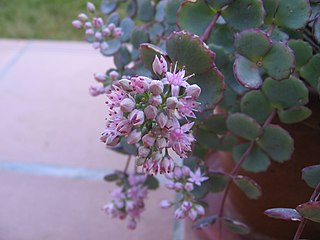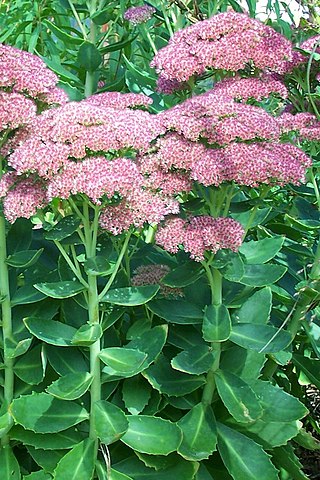
Sedum is a large genus of flowering plants in the family Crassulaceae, members of which are commonly known as stonecrops. The genus has been described as containing up to 600 species, subsequently reduced to 400–500. They are leaf succulents found primarily in the Northern Hemisphere, but extending into the southern hemisphere in Africa and South America. The plants vary from annual and creeping herbs to shrubs. The plants have water-storing leaves. The flowers usually have five petals, seldom four or six. There are typically twice as many stamens as petals. Various species formerly classified as Sedum are now in the segregate genera Hylotelephium and Rhodiola.

Sedum acre, commonly known as the goldmoss stonecrop, mossy stonecrop, goldmoss sedum, biting stonecrop, and wallpepper, is a perennial flowering plant in the family Crassulaceae. It is native to Europe, northern and western Asia and North Africa, but is also naturalised in North America, Japan, and New Zealand.

Hylotelephium telephium, known as orpine, livelong, frog's-stomach, harping Johnny, life-everlasting, live-forever, midsummer-men, Orphan John, witch's moneybags, and garden stonecrop is a succulent perennial plant of the family Crassulaceae native to Eurasia. The flowers are held in dense heads and can be reddish or yellowish-white. A number of cultivars, often with purplish leaves, are grown in gardens as well as hybrids between this species and the related Hylotelephium spectabile (iceplant), especially the popular 'Herbstfreude'. Occasionally garden plants may escape and naturalise as has happened in parts of North America.

Phedimus spurius, the Caucasian stonecrop or two-row stonecrop, is a species of flowering plant in the family Crassulaceae. It is still widely listed in the literature as Sedum spurium.

Hylotelephium spectabile is a species of flowering plant in the stonecrop family Crassulaceae, native to China and Korea. Its common names include showy stonecrop, iceplant, and butterfly stonecrop.

Hylotelephium is a genus of flowering plants in the stonecrop family Crassulaceae. It includes about 33 species distributed in Asia, Europe, and North America.

Sedum album, the white stonecrop, is a flowering plant of the genus Sedum in the family Crassulaceae. It is found in the northern temperate regions of the world, often growing in crevices or free-draining rocky soil. As a long-day plant it grows vegetatively for most of the year and flowers in summer.

Hylotelephium cauticola, the cliff stonecrop, syn. Sedum cauticola, is a species of flowering plant in the family Crassulaceae, native to Hokkaido, Japan. Growing to 8 cm (3 in) tall by 30 cm (12 in) wide, it is a carpet-forming succulent perennial with trailing stems of pink-tinged grey-green round leaves, and purplish pink star-shaped flowers in autumn.

Sedum eastwoodiae is a rare species of flowering plant of the stonecrop Crassulaceae family. It is known by its common name Red Mountain stonecrop. It is endemic to Mendocino County, California, where it is known from only four occurrences on Red Mountain, near Ukiah. The total number of plants in existence is estimated to be around 5300. They can be found on steep, exposed, rocky mountain slopes of serpentine substrate. This species has also been treated as a subspecies of Sedum laxum.

Sedum lanceolatum is a species of flowering plant in the family Crassulaceae known by the common names spearleaf stonecrop and lanceleaf stonecrop.

Sedum laxum is a species of flowering plant in the family Crassulaceae known by the common name roseflower stonecrop. It is native to southwestern Oregon and northwestern California, where it can be found in rocky mountainous habitat. It is a succulent plant forming basal rosettes of oval or oblong leaves up to 3 centimeters long. The inflorescence is made up of one or more erect arrays of many flowers. The flowers have reddish or yellowish petals up to 1.3 centimeters long each.

Sedum spathulifolium is a species of flowering plant in the family Crassulaceae known by the common names broadleaf stonecrop, yellow stonecrop, and spoon-leaved stonecrop. An evergreen perennial, it is native to western North America from British Columbia to southern California, where it can be found often in shade in many types of rocky habitat in coastal and inland hills and mountains.

Hylotelephium sieboldii, the October stonecrop, Siebold's stonecrop, Siebold's sedum or October daphne, is a species of flowering plant in the family Crassulaceae, native to Japan. Growing to 10 cm (4 in) high by 20 cm (8 in) wide, this trailing deciduous perennial produces its round glaucous leaves in whorls of 3 around the delicate stems. The hot-pink flowers appear in autumn (fall).

Hylotelephium erythrostictum, commonly known as garden stonecrop, is a herbaceous perennial plant in the genus Hylotelephium, belonging to the family Crassulaceae.

Sedum dasyphyllum, also named Sedum burnatii and commonly known as Corsican stonecrop or thick-leaved stonecrop, is a low-growing succulent flowering plant of the genus Sedum in the family Crassulaceae.

Sedum villosum, known as the hairy stonecrop or purple stonecrop, is a biennial to perennial flowering plant. Its leaves, which are 3–8 mm (0.1–0.3 in) long and may be reddish in colour, are generally covered with hairs, although S. villosum var. glabratum may have hairless leaves. Individual flowers have five pink petals, each up to 5 mm (0.2 in) long.

Hylotelephium, syn. Sedum, is a genus of flowering plants in the family Crassulaceae. Various species have been hybridized by horticulturalists to create new cultivars. Many of the newer ones are patented.

Sedum hispanicum, the Spanish stonecrop, is a species of plant in the family Crassulaceae.

Phedimus kamtschaticus, the orange stonecrop, is a species of flowering plant in the family Crassulaceae. It is native to China, Korea, Japan and the Russian Far East north to Chukotka, and has been introduced to the state of New York, Norway, Germany, Austria, and the Baltic States.
Hylotelephium cyaneum, commonly known as the azure stonecrop, is a perennial mat-forming succulent groundcover plant of the family Crassulaceae. Its native range is in eastern Siberia and Russian Far East.






















